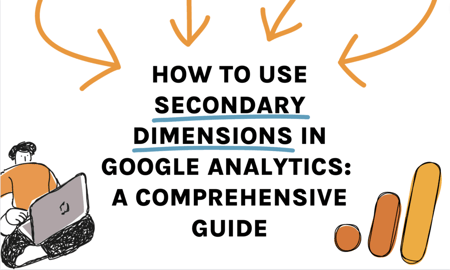A Comprehensive Overview to Secondary Dimensions in Google Analytics: Introduction Its Role in Data Interpretation
A Comprehensive Overview to Secondary Dimensions in Google Analytics: Introduction Its Role in Data Interpretation
Blog Article
Introducing the Impact of Secondary Measurement in Google Analytics on Information Analysis and Insights
In the realm of data analytics, the application of second dimensions within Google Analytics has actually emerged as a critical device for drawing out much deeper understandings and unraveling complex patterns that may otherwise continue to be obscured. By peeling off back the layers of primary data collections, additional measurements use a nuanced viewpoint that improves the understanding of user behavior, internet site efficiency, and the effectiveness of marketing methods. The real influence and untapped potential of additional measurements are commonly taken too lightly, overshadowed by the appeal of key metrics. As we navigate through the complex landscape of information evaluation, the relevance of second measurements ends up being significantly obvious, dropping light on critical details that hold the secret to informed decision-making and critical optimizations.
Exploring the Concept of Second Measurements
Second dimensions in Google Analytics give extra understandings by allowing individuals to analyze main information in conjunction with a secondary attribute. By including second measurements, customers can delve much deeper into the data and uncover important relationships that may or else go undetected - what is a secondary dimension in google analytics.
By discovering the different additional measurements offered in Google Analytics, individuals can open new understandings and optimize their digital advertising and marketing efforts. In significance, additional dimensions serve as an effective device for boosting information evaluation and driving workable outcomes.
Enhancing Information Interpretation With Additional Dimensions
Having actually developed the foundational understanding of secondary dimensions in Google Analytics and their pivotal duty in information analysis, the emphasis currently shifts in the direction of leveraging these additional qualities to improve the analysis of analytics information (what is a secondary dimension in google analytics). By incorporating second measurements into information analysis, experts can get deeper understandings into customer habits, website efficiency, and advertising effectiveness

Furthermore, second measurements assist in contextualizing primary information metrics by supplying additional layers of details. This contextualization help in comprehending the 'why' behind the data fads, assisting analysts make educated decisions and optimizations to enhance overall efficiency. Ultimately, incorporating second dimensions improves the data interpretation procedure, leading to even more calculated actions and purposeful insights.
Revealing Hidden Insights Through Second Dimensions
Discovering the depths of analytics information with secondary measurements reveals useful insights that would certainly or else stay obscured. By integrating secondary measurements in Google Analytics, services can unearth surprise patterns, fads, and relationships that give a more thorough understanding of individual actions and site efficiency. These additional layers of information permit analysts to dive deeper into the key measurements, such as traffic sources or touchdown web pages, and gain an extra nuanced perspective on how various variables engage with each various other.
Via using secondary dimensions, experts can section and compare information throughout various dimensions, enabling them to determine details factors that influence individual involvement, conversion prices, and overall success metrics. By pairing the primary measurement of 'tool group' with the secondary dimension of 'age group,' online marketers can identify which age demographics favor accessing the website via mobile tools versus desktop computers. This degree of granularity encourages businesses to make data-driven decisions and enhance their techniques for better results. Eventually, revealing hidden insights through secondary dimensions improves the deepness and precision of information analysis, resulting in more educated decision-making and boosted efficiency results.
Leveraging Additional Dimensions for Actionable Analytics
Structure upon the insights introduced with second dimensions in Google Analytics, services can currently harness this enriched data landscape to drive workable analytics and calculated decision-making. By leveraging secondary measurements, companies can dig much deeper into their information to remove useful patterns, trends, and relationships that may have formerly gone undetected. This deeper level of evaluation enables services to gain a much more comprehensive understanding of individual actions, campaign efficiency, and total site performance.
One key advantage of using second measurements for workable analytics is the capacity to section information based upon particular criteria. This division permits companies to tailor their approaches and campaigns to various audience groups, causing more targeted and effective advertising efforts - what is a secondary dimension in google analytics. In addition, secondary dimensions offer an even more holistic sight of user interactions, allowing services to enhance their internet site web content, layout, and total user experience
Making Best Use Of Decision-Making With Secondary Dimensions
To enhance strategic decision-making in analytics, leveraging secondary dimensions in Google Analytics can offer a much more nuanced point of view on individual habits and project efficiency. By integrating additional measurements into data analysis, services can dive much deeper right into the specifics of their internet site site visitors' communications and interaction patterns. This extra layer of info permits a much more extensive understanding of how different variables, such as demographics, devices, or traffic sources, influence crucial efficiency indicators.

Final Thought
In conclusion, using additional dimensions in Google Analytics plays an essential duty in enhancing data evaluation and discovering concealed insights. By discovering this idea, one can get a much deeper understanding of individual actions and make informed decisions based upon actionable analytics. Leveraging additional dimensions permits a much more thorough analysis of information and makes best use of the performance of decision-making processes.

Report this page